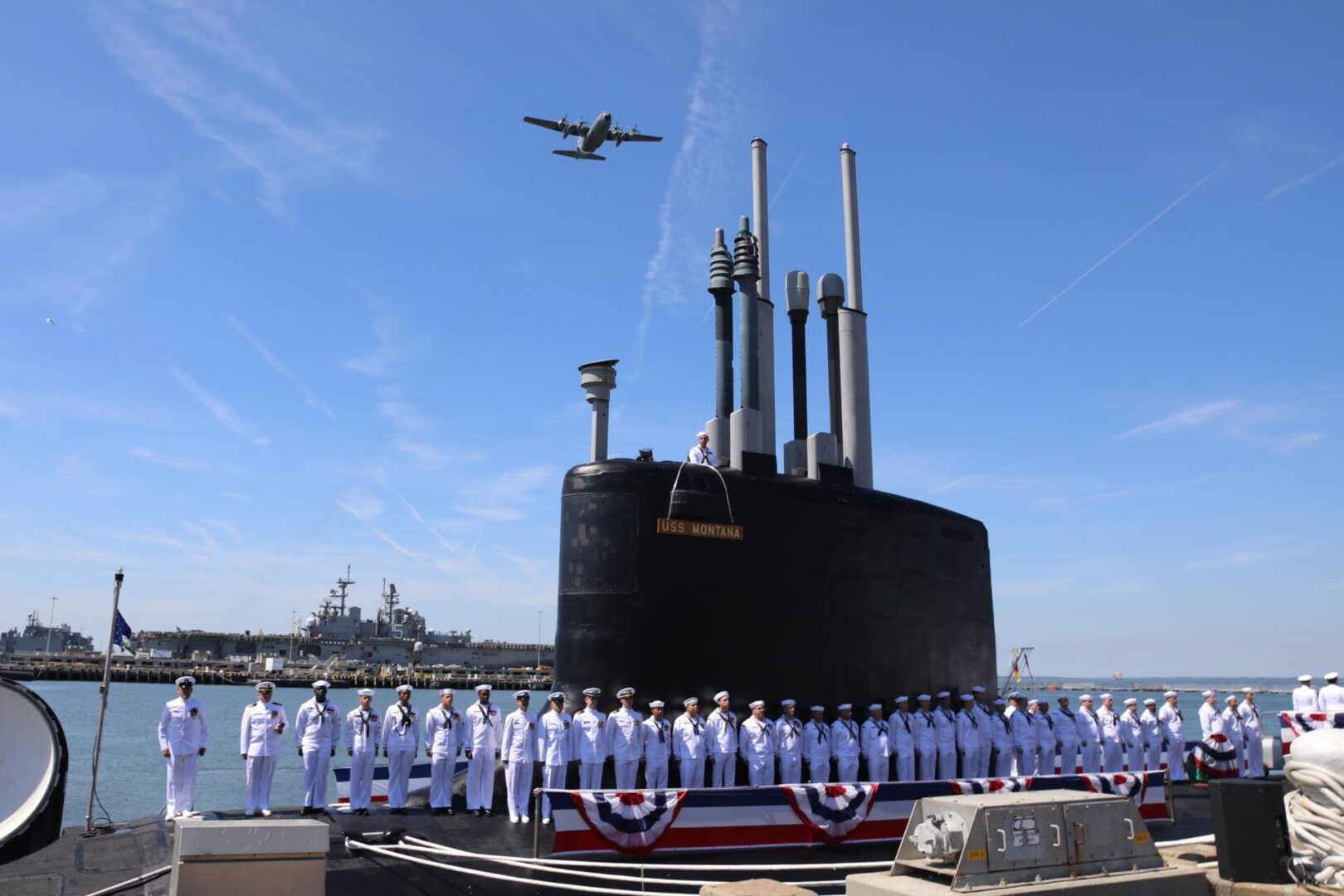
USS Montana (SSN 794) Commissioned
NORFOLK (June 25, 2022) Sailors attached to the Virginia-class fast attack submarine USS Montana (SSN 794) man the boat during a commissioning ceremony in Norfolk, Va., June 25, 2022. SSN-794, the second U.S Navy vessel launched with the name Montana and first in more than a century, is a flexible, multi-mission platform designed to carry out the seven core competencies of the submarine force: anti-submarine warfare; anti-surface warfare; delivery of special operations forces; strike warfare; irregular warfare; intelligence, surveillance and reconnaissance; and mine warfare. (U.S. Navy photo by Senior Chief Mass Communication Specialist John Smolinski)
(Original article appears courtesy of Navy.mil)
The Navy commissioned the Virginia-class fast-attack submarine USS Montana (SSN 794) in a traditional ceremony held Saturday, June 25, at Naval Station Norfolk.
Under Secretary of the Navy Erik K. Raven, highlighted the Montana’s capabilities and the importance of its crew in maintaining undersea dominance for the fleet.
“When USS Montana joins that fleet, she will add next generation of stealth, surveillance, and special warfare capabilities to our Joint Force, and extend our integrated deterrence capabilities,” said Raven. “This powerful boat and her crew will protect our sea lanes, strengthen our maritime dominance, and contribute to strengthening our relationships with our allies and partners.”
Raven continued to highlight the hard work and dedication needed by the shipyard, crew and all others involved to bring Montana to life.
“We’re here because of the detailed focus of every engineer, technician, builder and Sailor who had a hand in this platform,” said Raven. “USS Montana is proof of what our civilian, contractor and military teams can accomplish together.”
Adm. Frank Caldwell, director of the Naval Nuclear Propulsion Program, shared Raven’s sentiment on the importance of the Submarine Force in safeguarding our National Security.
“Today we enjoy a powerful advantage in the undersea realm,” said Caldwell. “Where our competitors seek to challenge the United States in all domains, it is a national imperative that we maintain that advantage.”
Caldwell went on to speak on the capabilities Montana and its crew will bring to the Submarine Force.
“From this day forth you and the Montana team will carry the immense burden of defending our freedoms across the globe,” said Caldwell. “Be ready to answer that call – as ‘vigilantes of the deep’.”
Sally Jewell, former Secretary of the United States Department of Interior, is the ship sponsor. During Saturday’s commissioning event, Ms. Jewell gave the crew the traditional order to “man our ship and bring her to life,” after which Montana’s Sailors ceremonially ran aboard the submarine.
“With awe I have witnessed the USS Montana come to life through hardworking shipbuilders, capable submariners and supportive families—all operating through a global pandemic—to ready her for service to our nation and allies,” said Jewell. “I’m proud of the impact the USS Montana will have in furthering freedom around the world, and confident she will live up to the spirit of adventure and resilience of her namesake state.”
The future USS Montana (SSN 794) honors the Treasure State. It will be the second commissioned warship bearing the name. The first USS Montana (ACR-13), an armored cruiser, was also built at Newport News Shipbuilding and commissioned July 1908. It served in the Atlantic and Mediterranean, landed Marines during unrest in Haiti in 1914 and escorted convoys during World War I. It was decommissioned in 1921.
Montana was previously christened in a traditional ceremony at Huntington Ingalls Newport News Shipbuilding in Virginia on Sept. 12, 2020.
Montana is the third of the Block IV Virginia-class submarines to be delivered.
Block IV Virginia-class submarines incorporate design changes focused on reduced total ownership cost. By making these smaller-scale design changes to increase the component-level lifecycle of the submarine, the Navy will increase the periodicity between depot maintenance availabilities and increase the number of deployments.
Blocks I-III Virginia-class submarines are planned to undergo four depot maintenance availabilities and conduct 14 deployments. Block IV design changes are intended to reduce planned availabilities by one to three, and increase deployments to 15.
Fast-attack submarines are multi-mission platforms enabling five of the six Navy maritime strategy core capabilities – sea control, power projection, forward presence, maritime security and deterrence. They are designed to excel in anti-submarine warfare, anti-ship warfare, strike warfare, special operations, intelligence, surveillance and reconnaissance, irregular warfare and mine warfare. Fast-attack submarines project power ashore with special operations forces and Tomahawk cruise missiles in the prevention or preparation of regional crises.
The Submarine Force executes the Department of the Navy’s mission in and from the undersea domain. In addition to lending added capacity to naval forces, the Submarine Force, in particular, is expected to leverage those special advantages that come with undersea concealment to permit operational, deterrent and combat effects that the Navy and the nation could not otherwise achieve.
The Submarine Force and supporting organizations constitute the primary undersea arm of the Navy. Submarines and their crews remain the tip of the undersea spear.
Tags: commissioning, commissionings, uss montana
